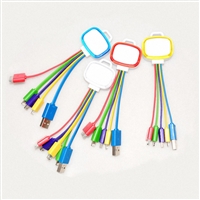
USB 2.0 was released in April 2000, adding a higher maximum signaling rate of 480 Mbit/s (High Speed or High Bandwidth), in addition to the USB 1.x Full Speed signaling rate of 12 Mbit/s. Due to bus access constraints, the effective throughput of the High Speed signaling rate is limited to 280 Mbit/s or 35 MB/s....
USB 2.0 was released in April 2000, adding a higher maximum signaling rate of 480 Mbit/s (High Speed or High Bandwidth), in addition to the USB 1.x Full Speed signaling rate of 12 Mbit/s. Due to bus access constraints, the effective throughput of the High Speed signaling rate is limited to 280 Mbit/s or 35 MB/s.
Further modifications to the USB specification have been made via Engineering Change Notices (ECN). The most important of these ECNs are included into the USB 2.0 specification package available from USB.org:
Mini-A and Mini-B Connector ECN: Released in October 2000.
Specifications for Mini-A and Mini-B plug and receptacle. Also receptacle that accepts both plugs for On-The-Go. These should not be confused with Micro-B plug and receptacle.
Pull-up/Pull-down Resistors ECN: Released in May 2002
Interface Associations ECN: Released in May 2003.
New standard descriptor was added that allows associating multiple interfaces with a single device function.
Rounded Chamfer ECN: Released in October 2003.
A recommended, backward compatible change to Mini-B plugs that results in longer lasting connectors.
Unicode ECN: Released in February 2005.
This ECN specifies that strings are encoded using UTF-16LE. USB 2.0 specified Unicode, but did not specify the encoding.
Inter-Chip USB Supplement: Released in March 2006
On-The-Go Supplement 1.3: Released in December 2006.
USB On-The-Go makes it possible for two USB devices to communicate with each other without requiring a separate USB host. In practice, one of the USB devices acts as a host for the other device.
Battery Charging Specification 1.1: Released in March 2007 and updated on 15 April 2009.
Adds support for dedicated chargers (power supplies with USB connectors), host chargers (USB hosts that can act as chargers) and the No Dead Battery provision, which allows devices to temporarily draw 100 mA current after they have been attached. If a USB device is connected to a dedicated charger, maximum current drawn by the device may be as high as 1.8 A. (Note that this document is not distributed with USB 2.0 specification package, only USB 3.0 and USB On-The-Go.)
Micro-USB Cables and Connectors Specification 1.01: Released in April 2007.
Link Power Management Addendum ECN: Released in July 2007.
This adds sleep, a new power state between enabled and suspended states. Device in this state is not required to reduce its power consumption. However, switching between enabled and sleep states is much faster than switching between enabled and suspended states, which allows devices to sleep while idle.
Battery Charging Specification 1.2: Released in December 2010.
Several changes and increasing limits including allowing 1.5 A on charging ports for unconfigured devices, allowing High Speed communication while having a current up to 1.5 A and allowing a maximum current of 5 A.
Customer Service
